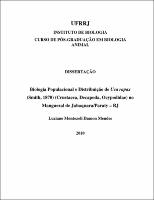Please use this identifier to cite or link to this item:
https://rima.ufrrj.br/jspui/handle/20.500.14407/10856Full metadata record
| DC Field | Value | Language |
|---|---|---|
| dc.contributor.author | Mendes, Luziane Montezoli Damon | pt_BR |
| dc.date.accessioned | 2023-12-22T01:43:46Z | - |
| dc.date.available | 2023-12-22T01:43:46Z | - |
| dc.date.issued | 2010-03-23 | |
| dc.identifier.citation | MENDES, Luziane Montezoli Damon. Biologia populacional e distribuição de Uca rapax (Smith, 1870) (Crustacea, Decapoda, Ocypodidae) no manguezal de Jabaquara/Paraty - RJ. 2010. 61 f. Dissertação (Mestrado em Biologia Animal) - Instituto de Ciências Biológicas e da Saúde, Universidade Federal Rural do Rio de Janeiro, Seropédica, 2010. | por |
| dc.identifier.uri | https://rima.ufrrj.br/jspui/handle/20.500.14407/10856 | - |
| dc.description.abstract | Aspectos da biologia populacional e distribuição foram estudados em uma população de caranguejos Uca rapax (Smith, 1870) no manguezal de Jabaquara/Paraty, Rio de Janeiro, Brasil (23º14'12,8"S e 44º42'37,1"W). Dois coletores capturaram os caranguejos mensalmente (de julho de 2007 a junho de 2008) durante 15 minutos por meio da técnica de esforço de captura em período de maré baixa em seis transectos. Amostras do sedimento foram coletadas nos seis transectos, para determinar o tamanho das partículas e matéria orgânica.Um total de 3093 espécimes foram coletados, sendo 2067 machos e 1026 fêmeas (148 fêmeas ovígeras). A razão sexual diferiu significativamente de 1:1 e a distribuição de frequência foi unimodal. Os machos foram atingiram tamanhos maiores que as fêmeas. O maior quelípodo é o esquerdo em 53,27% dos machos. As fêmeas ovígeras representaram 14,42 % da população. As fêmeas ovígeras foram mais abundantes durante os meses mais quentes do ano (primavera-verão). A fecundidade individual variou entre 420 a 22960 ovos (5544 + 4365,57). O tamanho médio dos ovos foi de 0,268 + 0,047 mm, variando entre 0,187 a 0,392 mm, enquanto o volume médio foi de 0,009 mm3. A análise de regressão evidencia que o número de ovos aumenta linearmente com o aumento do tamanho da carapaça. Os resultados revelam que a distribuição da população está intimamente relacionada ao tipo de substrato. U. rapax, foi encontrada principalmente em regiões arenosas e com alta concentração de matéria orgânica | por |
| dc.format | application/pdf | por |
| dc.language | por | por |
| dc.publisher | Universidade Federal Rural do Rio de Janeiro | por |
| dc.rights | Acesso Aberto | por |
| dc.subject | biologia populacional | por |
| dc.subject | distribuição | por |
| dc.subject | manguezal de Jabaquara | por |
| dc.subject | Uca rapax | por |
| dc.subject | distribution | eng |
| dc.subject | Jabaquara`s mangrove | eng |
| dc.subject | population biology | eng |
| dc.title | Biologia populacional e distribuição de Uca rapax (Smith, 1870) (Crustacea, Decapoda, Ocypodidae) no manguezal de Jabaquara/Paraty - RJ | por |
| dc.title.alternative | Population biology and distribution of Uca rapax (Smith, 1870) (Crustacea, Decapoda, Ocypodidae) in the Jabaquara`s mangrove/Paraty-RJ | eng |
| dc.type | Dissertação | por |
| dc.description.abstractOther | The population biology and distribution were studied in one population of the crab Uca rapax (Smith, 1870) in the mangrove Jabaquara/Paraty, Rio de Janeiro, Brazil (23º14'12,8"S e 44º42'37,1"W). Two collectors captured the crabs monthly (from July 2007 to June 2008) during 15 minutes by procedure of capture per unit effort in low tide periods in six transects. Sediment samples from all the transects were collected to determine particle size and organic matter. A total of 3093 specimes were collected, being 2067 males, 1026 females (148 ovigerous females). The sex ratio differed significanthy from: 1:1 (male: female) and the frequency distribution was uni-modal. The males attained a larger size than the females.The major cheliped is the left one in 53.27% of males. Ovigerous females accounted only about 14.42% of the population. Ovigerous females was most abundant during the warmer months of the year (Spring-summer). Individual fecundity varied from 420 to 22960 eggs (5544 + 4365,57). Mean eggs size was 0.268 + 0.047 mm, varying from 0.187 to 0.392 mm, while the mean volume was 0.009 mm3. The regression analysis show that the number of eggs increases linearly with the increase of the carapace width. The results indicated that distribution of population can be explained by its relationship with the sediment thickness. U rapax were collected, primarily in areas with the sand and high concentrations of organic matter. | eng |
| dc.contributor.advisor1 | Oshiro, Lidia Miyako Yoshii | pt_BR |
| dc.contributor.advisor1ID | 987.007.668-87 | por |
| dc.contributor.advisor1Lattes | http://buscatextual.cnpq.br/buscatextual/visualizacv.do?id=K4783239Y6 | por |
| dc.creator.ID | 026.684.297-65 | por |
| dc.creator.Lattes | http://lattes.cnpq.br/1851141796854064 | por |
| dc.publisher.country | Brasil | por |
| dc.publisher.department | Instituto de Ciências Biológicas e da Saúde | por |
| dc.publisher.initials | UFRRJ | por |
| dc.publisher.program | Programa de Pós-Graduação em Biologia Animal | por |
| dc.subject.cnpq | Ecologia | por |
| dc.thumbnail.url | https://tede.ufrrj.br/retrieve/55960/2010%20-%20Luziane%20Montezoli%20Damon%20Mendes.pdf.jpg | * |
| dc.originais.uri | https://tede.ufrrj.br/jspui/handle/tede/174 | |
| dc.originais.provenance | Made available in DSpace on 2016-04-26T18:59:54Z (GMT). No. of bitstreams: 1 2010 - Luziane Montezoli Damon Mendes.pdf: 4052748 bytes, checksum: a87b9eabc22b4eb9011bc1b52c8fd91d (MD5) Previous issue date: 2010-03-23 | eng |
| Appears in Collections: | Mestrado em Biologia Animal | |
Se for cadastrado no RIMA, poderá receber informações por email.
Se ainda não tem uma conta, cadastre-se aqui!
Files in This Item:
| File | Description | Size | Format | |
|---|---|---|---|---|
| 2010 - Luziane Montezoli Damon Mendes.pdf | Documento principal | 3.96 MB | Adobe PDF |  View/Open |
Items in DSpace are protected by copyright, with all rights reserved, unless otherwise indicated.

